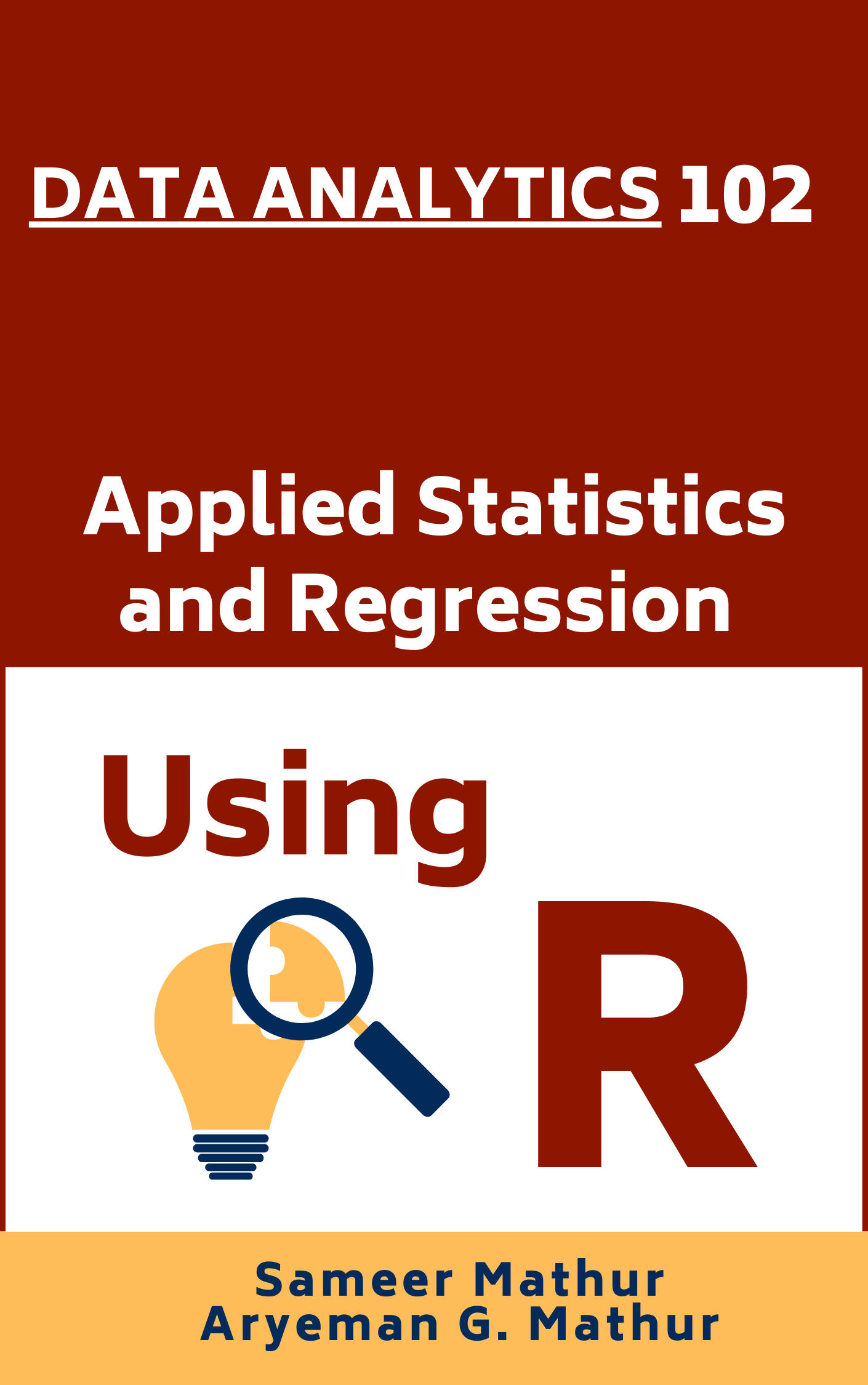References
[1]
Kutner, M. H., Nachtsheim, C. J., Neter, J., & Li, W. (2005). Applied linear regression models (4th ed.). McGraw-Hill Irwin.
Montgomery, D. C., Peck, E. A., & Vining, G. G. (2012). Introduction to linear regression analysis (5th ed.). Wiley.
James, G., Witten, D., Hastie, T., & Tibshirani, R. (2013). An introduction to statistical learning: With applications in R. Springer.
Agresti, A., & Finlay, B. (2009). Statistical methods for the social sciences (4th ed.). Pearson.
Hair, J. F., Black, W. C., Babin, B. J., & Anderson, R. E. (2010). Multivariate data analysis (7th ed.). Pearson Education.
[2]
Berkowitz, E. N. (2010). Essentials of healthcare marketing (3rd ed.). Jones & Bartlett Learning.
Jain, S. (2018). Marketing data science: Modeling techniques in predictive analytics with R and Python. Apress.
Kotler, P., & Keller, K. L. (2016). Marketing management (15th ed.). Pearson.
Malhotra, N. K., & Birks, D. F. (2006). Marketing research: An applied approach (3rd ed.). Pearson.
McCarthy, J. E., & Perreault Jr, W. D. (2018). Basic marketing: A marketing strategy planning approach (20th ed.). McGraw-Hill.
[3]
Bodie, Z., Kane, A., & Marcus, A. J. (2014). Investments (10th ed.). McGraw-Hill Education.
Altman, E. I. (1968). Financial ratios, discriminant analysis and the prediction of corporate bankruptcy. The Journal of Finance, 23(4), 589-609.
Markowitz, H. (1952). Portfolio selection. The Journal of Finance, 7(1), 77-91.
Hull, J. C. (2017). Options, futures, and other derivatives (10th ed.). Pearson Education.
Ross, S. A., Westerfield, R. W., Jordan, B. D., & Roberts, G. S. (2018). Fundamentals of corporate finance (12th ed.). McGraw-Hill Education.
[4]
Aguinis, H. (2019). Performance management (3rd ed.). Pearson.
Saks, A. M. (2006). Antecedents and consequences of employee engagement. Journal of Managerial Psychology, 21(7), 600-619.
Schmitt, N., & Chan, D. (1998). Personnel selection: A theoretical approach. Lawrence Erlbaum Associates.
Phillips, J. M., & Gully, S. M. (2015). Strategic staffing (3rd ed.). Pearson.
Cox, T., & Blake, S. (1991). Managing cultural diversity: Implications for organizational competitiveness. Academy of Management Executive, 5(3), 45-56.
[5]
Kutner, M. H., Nachtsheim, C. J., Neter, J., & Li, W. (2005). Applied linear statistical models (5th ed.). McGraw-Hill.
Montgomery, D. C., Peck, E. A., & Vining, G. G. (2012). Introduction to linear regression analysis (5th ed.). Wiley.
Hair, J. F., Black, W. C., Babin, B. J., & Anderson, R. E. (2019). Multivariate data analysis (8th ed.). Cengage Learning.
Draper, N. R., & Smith, H. (1998). Applied regression analysis (3rd ed.). Wiley.
Field, A. (2013). Discovering statistics using IBM SPSS statistics (4th ed.). Sage.
[6]
Kutner, M. H., Nachtsheim, C. J., Neter, J., & Li, W. (2005). Applied linear statistical models (5th ed.). McGraw-Hill.
Montgomery, D. C., Peck, E. A., & Vining, G. G. (2012). Introduction to linear regression analysis (5th ed.). Wiley.
Hair, J. F., Black, W. C., Babin, B. J., & Anderson, R. E. (2019). Multivariate data analysis (8th ed.). Cengage Learning.
Draper, N. R., & Smith, H. (1998). Applied regression analysis (3rd ed.). Wiley.
Field, A. (2013). Discovering statistics using IBM SPSS statistics (4th ed.). Sage.
[7]
R Core Team (2021). R: A language and environment for statistical computing. R Foundation for Statistical Computing. http://www.R-project.org/
Venables, W. N., & Ripley, B. D. (2002). Modern applied statistics with S (4th ed.). Springer.
Fox, J., & Weisberg, S. (2019). An R companion to applied regression (3rd ed.). Sage.
Faraway, J. J. (2005). Linear models with R. Chapman and Hall/CRC.
James, G., Witten, D., Hastie, T., & Tibshirani, R. (2017). An introduction to statistical learning: With applications in R. Springer.
[8]
Bowerman, B. L., O’Connell, R. T., & Koehler, A. B. (2018). Forecasting, time series, and regression: An applied approach (5th ed.). Cengage Learning.
Gujarati, D. N., & Porter, D. C. (2009). Basic econometrics (5th ed.). McGraw-Hill.
Hair, J. F., Black, W. C., Babin, B. J., & Anderson, R. E. (2014). Multivariate data analysis (7th ed.). Pearson.
Kleinbaum, D. G., Kupper, L. L., Nizam, A., & Muller, K. E. (2008). Applied regression analysis and other multivariable methods (4th ed.). Thomson Brooks/Cole.
Tabachnick, B. G., & Fidell, L. S. (2013). Using multivariate statistics (6th ed.). Pearson.
Penn State University. (n.d.). Lesson 3: Multiple linear regression. Statistics 501: Regression Methods. Retrieved March 4, 2023, from https://online.stat.psu.edu/stat501/lesson/3
Freedman, D. A. (2009). Statistical models: Theory and practice. Cambridge University Press.
Gujarati, D. N. (2003). Basic econometrics (4th ed.). McGraw-Hill.
Hair, J. F., Black, W. C., Babin, B. J., & Anderson, R. E. (2014). Multivariate data analysis (7th ed.). Prentice Hall.
Wooldridge, J. M. (2013). Introductory econometrics: A modern approach (5th ed.). South-Western.
[9]
University of Illinois at Urbana-Champaign. (n.d.). Multiple linear regression. Statistics and Data Science Center. Retrieved March 4, 2023, from https://stat.ethz.ch/R-manual/R-devel/library/stats/html/lm.html
R Core Team. (2021). R: A language and environment for statistical computing. R Foundation for Statistical Computing. https://www.R-project.org/
Venables, W. N., Smith, D. M., & R Development Core Team. (2008). An introduction to R. Network Theory Limited. http://cran.r-project.org/doc/manuals/R-intro.pdf
[10]
R Core Team. (2021). R: A language and environment for statistical computing. R Foundation for Statistical Computing. https://www.R-project.org/
Wickham, H. (2016). ggplot2: Elegant graphics for data analysis. Springer-Verlag. https://ggplot2.tidyverse.org/
Fox, J. (2015). Applied regression analysis and generalized linear models (3rd ed.). Sage Publications.
Dalgaard, P. (2002). Introductory statistics with R (2nd ed.). Springer.
[11]
R Core Team. (2021). R: A language and environment for statistical computing. R Foundation for Statistical Computing. https://www.R-project.org/
Fox, J. (2015). Applied regression analysis and generalized linear models (3rd ed.). Sage Publications.
Faraway, J. J. (2014). Linear models with R (2nd ed.). CRC Press.
Weisberg, S. (2005). Applied linear regression (3rd ed.). Wiley.







